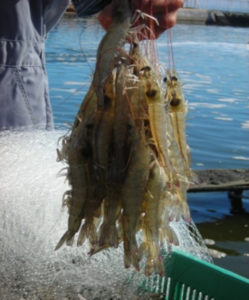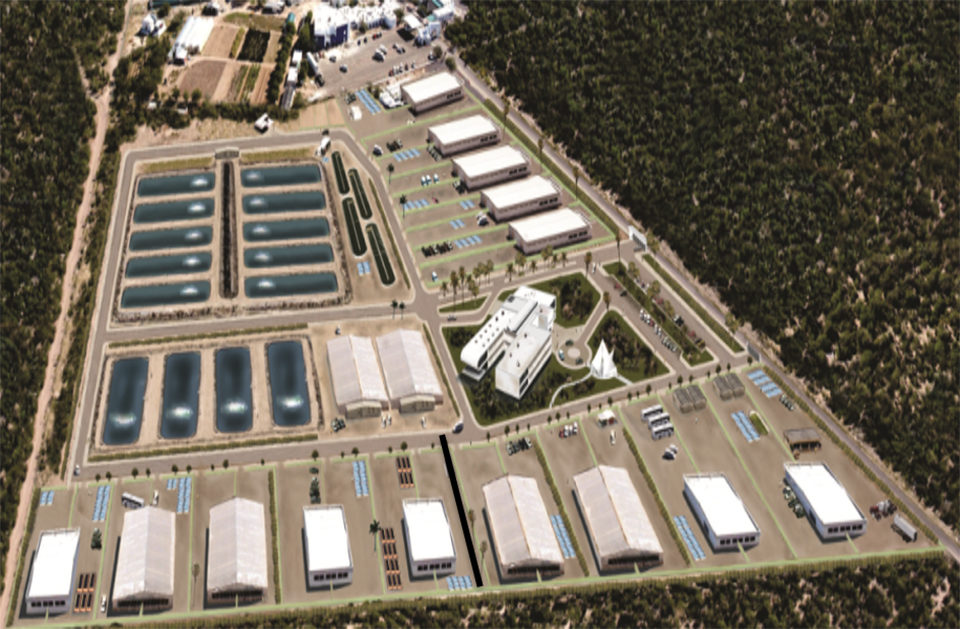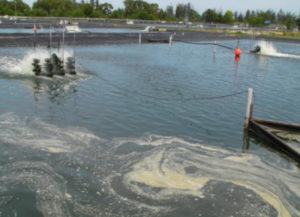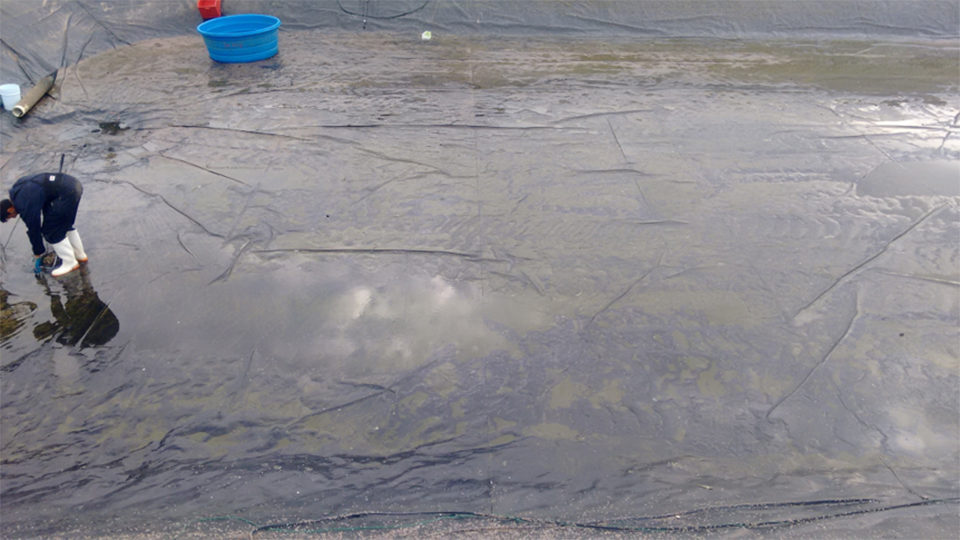System can dependably produce up to 14.7 metric tons of shrimp per hectare in 15 weeks

Shrimp farming in semiarid regions like northwest Mexico face high evaporation rates and salinities and challenging conditions for reduced water exchange to increase biosecurity and production efficiency.
Various authors have reported no decreases in production from reduced water exchange in these environmental conditions, including reports of no negative effects from seawater exchange reductions in semi-intensive systems in northwest Mexico. In the state of Baja California Sur (BCS), located in this region, intensive shrimp production depends on night aeration and daily seawater exchanges of at least 20 percent per day – this is based on set schedules and not on monitoring of pond water quality.
While previous studies indicated that high salinities can negatively affect shrimp growth, we anticipated that the physiological resilience of Pacific white shrimp (Litopenaeus vannamei) would support adequate growth rates when using a photo-heterotrophic system in high salinities.
We have been testing a photo-heterotrophic system (also called semi-biofloc or green-floc) in our semi-arid conditions. The objective is to take advantage of the phototrophic and heterotrophic processes working together by maintaining active particle suspension in the water column through continuous aeration. This allows for minimal or no water exchange, resulting in system stabilization and the effective nutrient recycling.
This article summarizes the original publication (DOI: 10.1111/are.13432) of a study that evaluated the potential for intensive production of L. vannamei in hypersaline, lined ponds with photo-heterotrophic system conditions and limited seawater replacement. No previous reports where found in the literature of any such studies. Using stochastic and stock models – which allows for a more complete analysis of the information compared with conventional statistical tools – we studied the influence of water quality parameters on survival and growth of shrimp and to predict yield variability.
This work was funded by the FINNOVA project #192666 awarded to Dr. Humberto Villarreal. Luis D. Moreno-Figueroa is recipient of a student fellowship from Consejo Nacional de Ciencia y Tecnología of Mexico (CONACYT). Also, we acknowledge the technical assistance of Jesus Aguilar of CIBNOR and the critical comments of an anonymous reviewer.

Experimental setup
We conducted the study at BioHelis – the Innovation and Technology Park, located at the Northwest Biological Research Center in La Paz, Baja California Sur, Mexico – using six, 1,000-square-meter, 1.35-meter-deep, plastic lined ponds filled with seawater (37 grams/L salinity). Fourteen days before stocking, ponds were fertilized daily with a commercial mix of nitrate (15 percent), silicon oxide (3.5 percent) and sodium (25 percent), at a rate of 5 kg/hectare, and a commercial probiotic mix was added to each pond to promote a heterotrophic microbial complex, daily the first week and twice per week until the end of the study.

L. vannamei postlarvae (PL14) were obtained from a commercial hatchery in La Paz (BCS, Mexico), and stocked at 120 PL per square meter in the ponds. Shrimp were fed a commercial intensive diet (35 percent crude protein) by evenly distributing the ration four times per day. The initial feed rate was 10 percent of total biomass and progressively decreased to 2 percent by the end of the study.
No pond water was exchanged during the study, but a weekly seawater addition of 1.6 percent per day per pond was implemented after the first month, for evaporation recovery and salinity level maintenance. Aspirator aerators provided aeration 24 hours a day at a rate equivalent to 20 HP/ha during the first 30 days and increasing the to 40 HP/ha through the rest of the study. Temperature (T), dissolved oxygen (DO), pH and salinity (S) were routinely measured and ammonia, nitrate, nitrite, phosphate and alkalinity were measured once a week. Water samples were collected to measure sedimentary solids (SS).
For detailed information on the experimental setup; water quality monitoring; shrimp source, nursery and feeds; the stochastic model used and the statistical and sensitivity analyses performed, refer to the original publication.
Results and discussion
Using the stochastic model (95 percent confidence), final individual weight was estimated to vary from 12.36 to 14.49 grams (mean = 13.33 grams) and survival ranged from 78.7 to 89.8 percent with a mean of 84.2 percent. According to the model, temperature, final weight of shrimp and dissolved oxygen were the most important factors inducing variability in shrimp production. There was a trend for final weight to gain importance as time progressed, while the mortality rate had medium to low importance throughout the culture period.
Reduced water exchange is desirable in shrimp farming, not only for biosecurity and cost, but also because the water volume used to produce one kg of shrimp is a good indicator of culture system efficiency. We used an average of 2.3 cubic meters of seawater per kg of shrimp, significantly low when considering an average evaporation rate of 10 mm of the water column per day due to high temperatures, dry climate and high solar irradiance.
Villareal, hypersaline, Table 1
| Parameter | Value |
|---|---|
| Final weight (grams) | 13.33 ± 0.35 |
| Survival (%) | 84.3 ± 1.2 |
| FCR | 1.52 ± 0.01 |
| Growth rate (grams/week) | 0.95 ± 0.05 |
| Yield (MT/ha) | 13.44 ± 0.23 |
In hypersaline conditions, energy expenditure for routine metabolism in shrimp is expected to increase, so the average FCR in this trial (1.52) was not unexpected. The minimal water replacement and constant mechanical aeration we used in our photo-heterotrophic system stimulated microbial community development which helped degrade organic matter and other waste.

Survival of marine shrimp reared at low salinities may vary and be influenced by the ionic composition of the water and other factors, but shrimp survival in our study was the same for both treatments and was not significantly different among treatments in this trial. L. vannamei has shown significant adaptation and tolerance capabilities to varying salinities, and adequate growth can be obtained between salinities of 25 and 45 grams/L.
Our stock model successfully predicted the dynamics of production of L. vannamei, due to adequate growth and survival equations, and the statistical models from the regression analysis. Based on the model, there is 95 percent confidence that our culture system could produce between 12.1 and 14.7 metric tons (MT)/ha (mean = 13.2 MT/ha) of shrimp.
Our results showed that the growth coefficient was inversely related to water temperature, while the mortality rate decreased when dissolved oxygen was high, and also showed a positive influence of higher temperatures for early growth of shrimp. But this early positive impact of temperature tended to diminish and the relevance of the variability in weight gain and dissolved oxygen increased as the culture period proceeded. And by the end of the study, yield variations were mainly explained by the random variability in final shrimp weight determined among the ponds, and by the differences in surviving populations based on the influence of dissolved oxygen on the mortality rate.
Sensitivity analysis showed that the mortality rate had a reduced effect on shrimp production due to the relatively stable high survival in our study, which was better than the reported maximum survival levels (70 to 80 percent) for semi-intensive shrimp farms in Mexico.
Perspectives
We were able to grow shrimp to a marketable size in fifteen weeks, indicating that two crops could be produced annually, an interesting alternative option for shrimp producers in Northwestern Mexico. Our stochastic modeling approach – properly adjusted and calibrated – generally could be used at shrimp located in other semi-arid regions. The recycling of nutrients from the photo-heterotrophic complex contributed to obtaining promissory results and maintaining adequate water quality in the system.
Based on our study results, we conclude that the use a hypersaline (37 to 45 grams/L) system for shrimp culture with minimal seawater replacement produces final weight, survival, yield and FCR comparable to those obtained in marine or brackish shrimp farming systems.
References available from first author.
Authors
-
Humberto Villarreal, Ph.D.
BioHelis
Innovation and Technology Park
Northwest Biological Research Center (CIBNOR)
Calle Instituto Politécnico Nacional #195
La Paz, Mexico -
Ing. Ac. Mayra Vargas
BioHelis
Innovation and Technology Park
Northwest Biological Research Center (CIBNOR)
Calle Instituto Politécnico Nacional #195
La Paz, Mexico -
Jose Naranjo, Ph.D.
BioHelis
Innovation and Technology Park
Northwest Biological Research Center (CIBNOR)
Calle Instituto Politécnico Nacional #195
La Paz, Mexico -
Alfredo Hernandez
BioHelis
Innovation and Technology Park
Northwest Biological Research Center (CIBNOR)
Calle Instituto Politécnico Nacional #195
La Paz, Mexico -
Luis D. Moreno
BioHelis
Innovation and Technology Park
Northwest Biological Research Center (CIBNOR)
Calle Instituto Politécnico Nacional #195
La Paz, Mexico -
Jose A. Hernandez
BioHelis
Innovation and Technology Park
Northwest Biological Research Center (CIBNOR)
Calle Instituto Politécnico Nacional #195
La Paz, Mexico
Tagged With
Related Posts

Responsibility
Electrical conductivity of water, part 2
The electrical conductivity of water is frequently measured in aquaculture systems and taken as an indicator of the degree of mineralization (total ion concentration) of water.

Health & Welfare
Larval rearing of sea bass in desert-saline Middle East
European sea bass have been raised in the favorable climate of the Middle East since 2000. For effective larval rearing of sea bass, the authors recommend the use of temperature-controlled water with about 35 ppt salinity and good aeration in tanks.

Responsibility
Saline aquaponics: Potential player in food, energy production
The integration of marine and brackish water aquaculture with plants can help lead to alternative food production on coastlines, in arid lands and in urban/periurban areas. Some 50 salt-tolerant plants could be cultivated for grains or biodiesel applications.

Health & Welfare
Ammonia addition enhances microbial flocs in nursery phase for Pacific white shrimp
In a study, “pre-fertilization” in the nursery phase of a biofloc system for shrimp was tested. The objective was to accelerate the biofloc formation to minimize ammonia concentrations, avoiding high peaks during culture.


